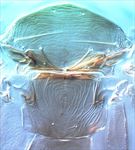Distinguishing features
Female macroptera. Body brown, abdomen light brown medially; femora brown, mid and hind tibiae brown with base yellow, tarsi yellow; antennal segment I as brown as head, II paler, III–IV yellow, V–IX brown; fore wings pale brown, basal area clear. Antennae 9-segmented, segment I with long toothed process; segment III parallel-sided; sensoria on III–IV incomplete dorsally, with weak internal markings; IX longer than VIII. Head with ocellar setae III long, arising on anterior margins of triangle. Pronotum almost without sculpture lines, with 4–6 pairs of discal setae, anteromedian pair longest; posterior angles with 2 pairs of long setae. Mesonotum with long lateral setae, no microtrichia on sculpture lines mesad of these setae. Metanotum with concentric lines at anterior bearing microtrichia, posterior half weakly sculptured. Fore wing setae longer than distance between veins. Fore tibial apex with two stout ventro-lateral setae Abdominal tergites I–VIII with no sculpture lines or microtrichia medially; tergite VIII median setae scarcely 0.25 as long as tergite; dorsal setae on IX–X slender. Sternite II with 2 pairs of posteromarginal setae and 0–1 discal setae; sternite III with 3 pairs of posteromarginal setae, IV–VI with 4 pairs; median sternites with 8–11 discal setae, sternite VII with discal setae laterally but not medially.
Male not known
Related species
Twelve species are currently described in the genus Cranothrips, 11 from Australia and one from South Africa (Pereyra & Mound, 2009). C. conostylus has particularly long lateral setae on the mesonotum, and the pronotum lacks sculpture lines.
Biological data
Breeding in the flowers of its hosts, Conostylus candicans [Haemodoraceae] and Geleznowia sp. [Rutaceae], and presumably pupating at soil level.
Distribution data
Western Australia, between Perth and Geraldton
Family name
MELANTHRIPIDAE
Species name
Cranothrips conostylus Pereyra & Mound
Original name and synonyms
Cranothrips conostylus Pereyra & Mound, 2009: 159
References
Pereyra V & Mound LA (2009) Phylogenetic relationships within the genus Cranothrips (Thysanoptera, Melanthripidae) with consideration of host associations and disjunct distributions within the family. Systematic Entomology 34: 151–161.





